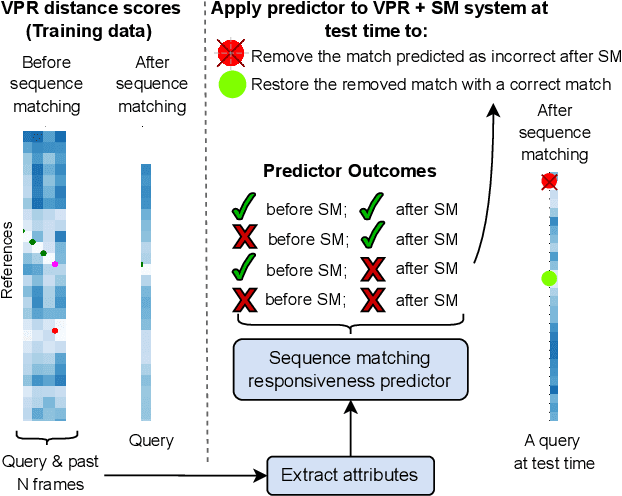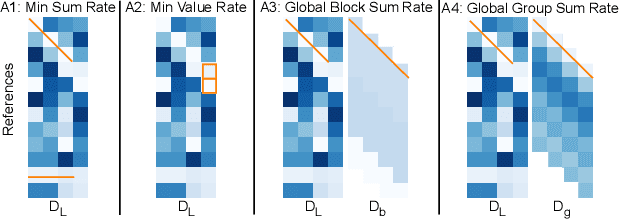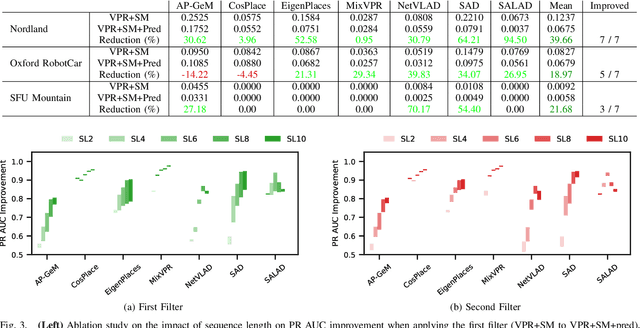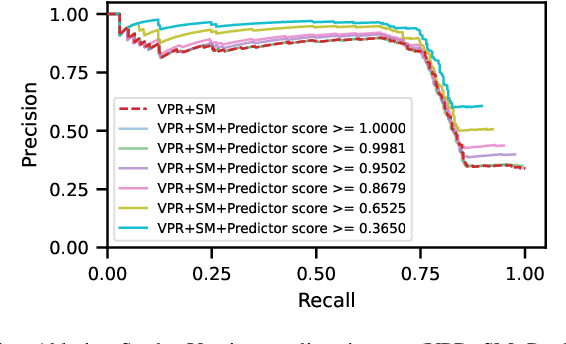Michael Milford
Event-LAB: Towards Standardized Evaluation of Neuromorphic Localization Methods
Sep 18, 2025Abstract:Event-based localization research and datasets are a rapidly growing area of interest, with a tenfold increase in the cumulative total number of published papers on this topic over the past 10 years. Whilst the rapid expansion in the field is exciting, it brings with it an associated challenge: a growth in the variety of required code and package dependencies as well as data formats, making comparisons difficult and cumbersome for researchers to implement reliably. To address this challenge, we present Event-LAB: a new and unified framework for running several event-based localization methodologies across multiple datasets. Event-LAB is implemented using the Pixi package and dependency manager, that enables a single command-line installation and invocation for combinations of localization methods and datasets. To demonstrate the capabilities of the framework, we implement two common event-based localization pipelines: Visual Place Recognition (VPR) and Simultaneous Localization and Mapping (SLAM). We demonstrate the ability of the framework to systematically visualize and analyze the results of multiple methods and datasets, revealing key insights such as the association of parameters that control event collection counts and window sizes for frame generation to large variations in performance. The results and analysis demonstrate the importance of fairly comparing methodologies with consistent event image generation parameters. Our Event-LAB framework provides this ability for the research community, by contributing a streamlined workflow for easily setting up multiple conditions.
Assessing the Geolocation Capabilities, Limitations and Societal Risks of Generative Vision-Language Models
Aug 27, 2025Abstract:Geo-localization is the task of identifying the location of an image using visual cues alone. It has beneficial applications, such as improving disaster response, enhancing navigation, and geography education. Recently, Vision-Language Models (VLMs) are increasingly demonstrating capabilities as accurate image geo-locators. This brings significant privacy risks, including those related to stalking and surveillance, considering the widespread uses of AI models and sharing of photos on social media. The precision of these models is likely to improve in the future. Despite these risks, there is little work on systematically evaluating the geolocation precision of Generative VLMs, their limits and potential for unintended inferences. To bridge this gap, we conduct a comprehensive assessment of the geolocation capabilities of 25 state-of-the-art VLMs on four benchmark image datasets captured in diverse environments. Our results offer insight into the internal reasoning of VLMs and highlight their strengths, limitations, and potential societal risks. Our findings indicate that current VLMs perform poorly on generic street-level images yet achieve notably high accuracy (61\%) on images resembling social media content, raising significant and urgent privacy concerns.
VLM-Guided Visual Place Recognition for Planet-Scale Geo-Localization
Jul 23, 2025Abstract:Geo-localization from a single image at planet scale (essentially an advanced or extreme version of the kidnapped robot problem) is a fundamental and challenging task in applications such as navigation, autonomous driving and disaster response due to the vast diversity of locations, environmental conditions, and scene variations. Traditional retrieval-based methods for geo-localization struggle with scalability and perceptual aliasing, while classification-based approaches lack generalization and require extensive training data. Recent advances in vision-language models (VLMs) offer a promising alternative by leveraging contextual understanding and reasoning. However, while VLMs achieve high accuracy, they are often prone to hallucinations and lack interpretability, making them unreliable as standalone solutions. In this work, we propose a novel hybrid geo-localization framework that combines the strengths of VLMs with retrieval-based visual place recognition (VPR) methods. Our approach first leverages a VLM to generate a prior, effectively guiding and constraining the retrieval search space. We then employ a retrieval step, followed by a re-ranking mechanism that selects the most geographically plausible matches based on feature similarity and proximity to the initially estimated coordinates. We evaluate our approach on multiple geo-localization benchmarks and show that it consistently outperforms prior state-of-the-art methods, particularly at street (up to 4.51%) and city level (up to 13.52%). Our results demonstrate that VLM-generated geographic priors in combination with VPR lead to scalable, robust, and accurate geo-localization systems.
TAT-VPR: Ternary Adaptive Transformer for Dynamic and Efficient Visual Place Recognition
May 22, 2025Abstract:TAT-VPR is a ternary-quantized transformer that brings dynamic accuracy-efficiency trade-offs to visual SLAM loop-closure. By fusing ternary weights with a learned activation-sparsity gate, the model can control computation by up to 40% at run-time without degrading performance (Recall@1). The proposed two-stage distillation pipeline preserves descriptor quality, letting it run on micro-UAV and embedded SLAM stacks while matching state-of-the-art localization accuracy.
Long Exposure Localization in Darkness Using Consumer Cameras
Apr 23, 2025Abstract:In this paper we evaluate performance of the SeqSLAM algorithm for passive vision-based localization in very dark environments with low-cost cameras that result in massively blurred images. We evaluate the effect of motion blur from exposure times up to 10,000 ms from a moving car, and the performance of localization in day time from routes learned at night in two different environments. Finally we perform a statistical analysis that compares the baseline performance of matching unprocessed grayscale images to using patch normalization and local neighborhood normalization - the two key SeqSLAM components. Our results and analysis show for the first time why the SeqSLAM algorithm is effective, and demonstrate the potential for cheap camera-based localization systems that function despite extreme appearance change.
VSLAM-LAB: A Comprehensive Framework for Visual SLAM Methods and Datasets
Apr 06, 2025



Abstract:Visual Simultaneous Localization and Mapping (VSLAM) research faces significant challenges due to fragmented toolchains, complex system configurations, and inconsistent evaluation methodologies. To address these issues, we present VSLAM-LAB, a unified framework designed to streamline the development, evaluation, and deployment of VSLAM systems. VSLAM-LAB simplifies the entire workflow by enabling seamless compilation and configuration of VSLAM algorithms, automated dataset downloading and preprocessing, and standardized experiment design, execution, and evaluation--all accessible through a single command-line interface. The framework supports a wide range of VSLAM systems and datasets, offering broad compatibility and extendability while promoting reproducibility through consistent evaluation metrics and analysis tools. By reducing implementation complexity and minimizing configuration overhead, VSLAM-LAB empowers researchers to focus on advancing VSLAM methodologies and accelerates progress toward scalable, real-world solutions. We demonstrate the ease with which user-relevant benchmarks can be created: here, we introduce difficulty-level-based categories, but one could envision environment-specific or condition-specific categories.
Improving Visual Place Recognition with Sequence-Matching Receptiveness Prediction
Mar 10, 2025



Abstract:In visual place recognition (VPR), filtering and sequence-based matching approaches can improve performance by integrating temporal information across image sequences, especially in challenging conditions. While these methods are commonly applied, their effects on system behavior can be unpredictable and can actually make performance worse in certain situations. In this work, we present a new supervised learning approach that learns to predict the per-frame sequence matching receptiveness (SMR) of VPR techniques, enabling the system to selectively decide when to trust the output of a sequence matching system. The approach is agnostic to the underlying VPR technique. Our approach predicts SMR-and hence significantly improves VPR performance-across a large range of state-of-the-art and classical VPR techniques (namely CosPlace, MixVPR, EigenPlaces, SALAD, AP-GeM, NetVLAD and SAD), and across three benchmark VPR datasets (Nordland, Oxford RobotCar, and SFU-Mountain). We also provide insights into a complementary approach that uses the predictor to replace discarded matches, as well as ablation studies, including an analysis of the interactions between our SMR predictor and the selected sequence length. We will release our code upon acceptance.
Image-Based Relocalization and Alignment for Long-Term Monitoring of Dynamic Underwater Environments
Mar 06, 2025



Abstract:Effective monitoring of underwater ecosystems is crucial for tracking environmental changes, guiding conservation efforts, and ensuring long-term ecosystem health. However, automating underwater ecosystem management with robotic platforms remains challenging due to the complexities of underwater imagery, which pose significant difficulties for traditional visual localization methods. We propose an integrated pipeline that combines Visual Place Recognition (VPR), feature matching, and image segmentation on video-derived images. This method enables robust identification of revisited areas, estimation of rigid transformations, and downstream analysis of ecosystem changes. Furthermore, we introduce the SQUIDLE+ VPR Benchmark-the first large-scale underwater VPR benchmark designed to leverage an extensive collection of unstructured data from multiple robotic platforms, spanning time intervals from days to years. The dataset encompasses diverse trajectories, arbitrary overlap and diverse seafloor types captured under varying environmental conditions, including differences in depth, lighting, and turbidity. Our code is available at: https://github.com/bev-gorry/underloc
TeTRA-VPR: A Ternary Transformer Approach for Compact Visual Place Recognition
Mar 04, 2025



Abstract:Visual Place Recognition (VPR) localizes a query image by matching it against a database of geo-tagged reference images, making it essential for navigation and mapping in robotics. Although Vision Transformer (ViT) solutions deliver high accuracy, their large models often exceed the memory and compute budgets of resource-constrained platforms such as drones and mobile robots. To address this issue, we propose TeTRA, a ternary transformer approach that progressively quantizes the ViT backbone to 2-bit precision and binarizes its final embedding layer, offering substantial reductions in model size and latency. A carefully designed progressive distillation strategy preserves the representational power of a full-precision teacher, allowing TeTRA to retain or even surpass the accuracy of uncompressed convolutional counterparts, despite using fewer resources. Experiments on standard VPR benchmarks demonstrate that TeTRA reduces memory consumption by up to 69% compared to efficient baselines, while lowering inference latency by 35%, with either no loss or a slight improvement in recall@1. These gains enable high-accuracy VPR on power-constrained, memory-limited robotic platforms, making TeTRA an appealing solution for real-world deployment.
Image-based Geo-localization for Robotics: Are Black-box Vision-Language Models there yet?
Jan 28, 2025



Abstract:The advances in Vision-Language models (VLMs) offer exciting opportunities for robotic applications involving image geo-localization, the problem of identifying the geo-coordinates of a place based on visual data only. Recent research works have focused on using a VLM as embeddings extractor for geo-localization, however, the most sophisticated VLMs may only be available as black boxes that are accessible through an API, and come with a number of limitations: there is no access to training data, model features and gradients; retraining is not possible; the number of predictions may be limited by the API; training on model outputs is often prohibited; and queries are open-ended. The utilization of a VLM as a stand-alone, zero-shot geo-localization system using a single text-based prompt is largely unexplored. To bridge this gap, this paper undertakes the first systematic study, to the best of our knowledge, to investigate the potential of some of the state-of-the-art VLMs as stand-alone, zero-shot geo-localization systems in a black-box setting with realistic constraints. We consider three main scenarios for this thorough investigation: a) fixed text-based prompt; b) semantically-equivalent text-based prompts; and c) semantically-equivalent query images. We also take into account the auto-regressive and probabilistic generation process of the VLMs when investigating their utility for geo-localization task by using model consistency as a metric in addition to traditional accuracy. Our work provides new insights in the capabilities of different VLMs for the above-mentioned scenarios.
 Add to Chrome
Add to Chrome Add to Firefox
Add to Firefox Add to Edge
Add to Edge